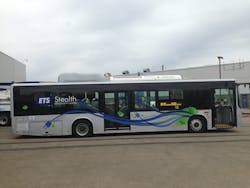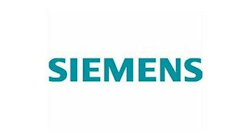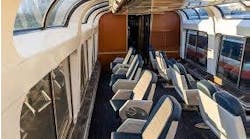When diesel prices began to skyrocket in 2007, StarMetro in Tallahassee, Fla., found itself in a pinch to pay for fuel.
The 72 bus fleet saw its fuel cost forecast dramatically impacted by the jump in diesel, so leaders there began to look into ways to try and control those costs. Some options explored by the agency included hydrogen and compressed natural gas, however, electric stood out as a viable option.
“Being a part of the city municipal government, the city also owns and operates the electric power generations,” said Ralph Wilder, StarMetro’s maintenance supervisor. “So the electric buses certainly fit well into that other niche.”
Wilder said StarMetro applied and got TIGER II money to purchase three Proterra buses and a fast charging system. More grant money was received and two more buses were purchased and in 2013, StarMetro put its new buses into service.
Wilder said the agency worked with the Center for Transportation and Environment to do modeling for the route structure to make sure it was a good fit for the fast charging electric bus technology and making sure the units ran on a highly visible route.
StarMetro put the Proterra buses into service on its Canopy route, which runs through the middle of the city, connects with virtually all other routes and has heavy ridership. The 20 mile route takes about 1 hour and the bus is charged at the transfer center during a 10 minute layover.
“Right onw the charging is averaging about seven minutes, which fits nicely in the 10 minute layover time, so the charging can be done very seamlessly,” Wilder said. “There’s no service interruption in that seamless type of function.”
“The buses themselves in my estimation have exceeded expectations,” he said. “The first three buses in the fleet were from very early in the build process for Proterra, it’s generation 1.0. There have been a few minor issues, most of them have been traditional bus-related technology problems and very limited problems with the powerplant technology.
“It’s 180-degrees different than I would expect.”
Training has been a bigger hurdler for StarMetro with the new buses in teaching both the operators and maintenance crews how to drive and fix the buses, Wilder said, but to understand the new technology it’s important reach out to other community resources as well.
“Develop a real good partnership with the electric utility,” he said. “They certainly have a lot more knowledge about these things and training and equipment, like having specialized gloves, which quite honestly, we would have never had or needed before.”
With the surprising results from the Proterra buses and the garnering of numbers to show the true economic impact, Wilder said there could be more ebuses coming to Tallahassee in the future given the satisfaction with Proterra.
“Were always looking for funding opportunities as well as some serious discussions for the next several years on bus replacement and what’s going to be the right mixture of how many electric buses, how many compressed natural gas buses and how many diesel buses are right for us,” he said. “It’s based not only on the power plant, but the seating capacity and demand for the vehicle.”
An emphasis on battery power
The city of Edmonton is also looking into the electric bus field with the testing of BYD buses within the Edmonton Transit System. Given the quiet nature of the electric buses, leaders there are calling the BYD units the “Stealth Bus” because it sneaks up on waiting passengers.
“I think for us, like everyone else, we recognize that we need to become more reliant on multiple fuels regardless of where we’re sitting here in an oil and natural gas rich province,” said Linda Kadatz, divisional supervisor for ETS and project manager for the Stealth Bus. “That stuff is finite after and at some point we’re going to have to address how we fuel our public utilities in a sustainable way.”
Kadatz said operators have needed to adjust to the electric bus because unlike a diesel bus, the electrics have a smoother takeoff and stopping action, and the regenerative power systems within the brakes allow for a recharge at every stop if done properly.
“And the passengers tell you how quiet it is. How very, very, very quiet it is. Almost eerily quite,” she said. “I think it may change the social experience of riding a bus because the driver can hear everything, so what that does for the conversations or the levels of music playing, when it comes to a stop, you can see the people hold their breath and it’s just really, really interesting.”
Although the Stealth Buses are only demos and therefore are not put to spec for Edmonton, Kadatz said riders seem to be pretty impressed with the overall experience while ETS is impressed with the run time. The BYD buses are doing 10 hours of duty on a single charge. The buses aren’t set up for the cold Edmonton winters, but Kadatz said the offer is out there to try one.
Kadatz said she still has questions about the buses because of their aluminum body and the damage it can incur along with the price.
“It’s attractive. The idea is very attractive,” she said. “It’s not so much about the bus because the bus is pretty plain Jane, but it’s the idea of where you’re going.”
Operational costs are being cut as well so far in the pilot, Kadatz said, with fuel costs slashed by one-third on the Stealth Buses along with other operational expenses.
“I see some of those numbers bearing down even now,” she said. “That’s a lot of dough we can save.”
Old guard of buses gets on board
While BYD and Proterra have gotten attention for being pure electric bus manufacturers, traditional bus builders are also starting to put their own models into service.
New Flyer has electric buses in Winnipeg and now in Chicago operated by the Chicago Transit Authority, which combine the Xcelsior buses with Siemens electric power plants. Chris Stoddart, vice president of engineering and customer service for New Flyer, said the company is very familiar with electric drive with work in trolley buses and hybrids, and the Siemens power plant is a mature technology used across the globe.
“To be honest, it’s not much different to design and there are no major technical hurdles,” he said. “We’ve got thousands of electric drive vehicles out there if you count trolley buses or hybrids, so really there’s no technical complexity to the integration. In fact, to the untrained eye, no one would notice a detectable difference from a traditional diesel bus other than when they ride and notice how quiet it is.”
The Winnipeg buses have a 200 kWh battery pack with on route charging, so Stoddart said they get about 21 hours or service. CTA opted for 300 kWh, so depending on the conditions, it can get 100-120 miles of range. Even though both are cold weather cities, testing has shown the buses can take it.
“The first bus was tested for two years in sort of a shuttle service and it has been through a couple of winters and we really didn’t notice any operational problems, even with multiple days below -20 Fahrenheit” he said. “One of the things that has to be considered in extreme cold environments is the use of auxiliary heaters.”
Stoddart said there has been an incredible amount of interest in electric buses from transit agencies and more will begin to dip their toes into the electric bus market, so there needs to be an adoption of formal charging standards before a mass adoption of electric buses occurs.
“It’s too much of a constraint on the end user if they have to have different chargers on different OEM specific routes,” he said. “I think the biggest challenge is to get an agreement on a common charging standards.”
Stoddart said New Flyer has looked at conductive charging units, but at this time is sticking with inductive because it’s proven and more than 100 years old. However, he said the company will continue to watch as conductive state-of-the-art technology matures.
Taking E-buses to the BRT level
With North American transit providers just starting to dip their toes into the electric bus market, agencies in Europe are already starting to take systems to the next level while turning back to the past for inspiration.
Les Transports Publics Genevois (TPG), in Geneva, Switzerland wanted to transform a trolleybus line into a next-generation service with more capacity and eliminate the need for overhead catenary lines to charge the bus. The agency partnered with the local power utility and ABB and came up with the Trolleybus Optimisation Systeme Alimentation (TOSA), which created a high capacity transit line, which can operate 24 hours per day with little dwell time needed for charging due to fast charging outlets along the line.
“It’s not just an electric bus,” said Daniel Simounet, director of market segment transportation for North America for ABB. “It’s a complete solution for a city that wants to invest in a high-capacity line, where you move a lot of passengers, like a BRT system.”
The 8 kilometer line has 40 kWh battery equipped articulated buses running along it designed to hold 134 passengers. Chargers are spaced about three to four stops apart and when the bus comes to a stop, a charger telescopes to the unit and provides a 15 second recharge using a fast charging system.
The quick charge doesn’t give the battery a full charge, but the battery has a 50 percent charge at the end of the line, where it undergoes a 2-3 minute charge to get it back to 100 percent.
“It’s like investing in streetcars where you’ll invest a lot in infrastructure for very efficient trains,” Simounet said. “When considering a BRT solution where you need a lot of capacity, there tends to be less because you have too much battery.
“A bigger aspect of the issue is that you have to recharge the battery and you have a big, huge battery, you will spend 5 hours recharging it, so you need another bus to provide the service.”
BRT is growing in North America, Simounet said, but it’s still very small and the fast charger TOSA system concept only makes sense on high capacity lines. There’s still issues with standardization in the technology in North America and a hesitance by transit agencies to undertake a new technology.
“For us as a technology provider, in this context, we don’t have a bus, we don’t sell a bus,” he said. “We have to put a lot of players together in order to have a project like this in North America.
“There is a willingness out there for this in some cities and some transit authorities would like to take the lead on this type of project and put the players together.”








